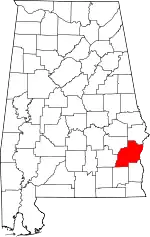Louisville, Alabama | |
|---|---|
 | |
 Location of Louisville in Barbour County, Alabama. | |
| Coordinates: 31°46′49″N 85°33′27″W / 31.78028°N 85.55750°W | |
| Country | United States |
| State | Alabama |
| County | Barbour |
| Area | |
| • Total | 2.75 sq mi (7.12 km2) |
| • Land | 2.75 sq mi (7.12 km2) |
| • Water | 0.00 sq mi (0.00 km2) |
| Elevation | 551 ft (168 m) |
| Population (2020) | |
| • Total | 395 |
| • Density | 143.74/sq mi (55.49/km2) |
| Time zone | UTC-6 (Central (CST)) |
| • Summer (DST) | UTC-5 (CDT) |
| ZIP code | 36048 |
| Area code | 334 |
| FIPS code | 01-44344 |
| GNIS feature ID | 0122049 |
Louisville (/ˈluːɪsvɪl/) is a town in Barbour County, Alabama, United States. Originally named "Lewisville" and still pronounced as such. At the 2020 census, the population was 395.
Geography
Louisville is 10 miles (16 km) southwest of Clayton, the county seat, and 6 miles (10 km) northeast of Clio.
According to the U.S. Census Bureau, the town has a total area of 2.8 square miles (7.1 km2), all land.[2]
Demographics
| Census | Pop. | Note | %± |
|---|---|---|---|
| 1880 | 211 | — | |
| 1890 | 288 | 36.5% | |
| 1900 | 416 | 44.4% | |
| 1910 | 483 | 16.1% | |
| 1920 | 504 | 4.3% | |
| 1930 | 587 | 16.5% | |
| 1940 | 662 | 12.8% | |
| 1950 | 622 | −6.0% | |
| 1960 | 890 | 43.1% | |
| 1970 | 785 | −11.8% | |
| 1980 | 791 | 0.8% | |
| 1990 | 728 | −8.0% | |
| 2000 | 612 | −15.9% | |
| 2010 | 519 | −15.2% | |
| 2020 | 395 | −23.9% | |
| U.S. Decennial Census[3] 2013 Estimate[4] | |||
2020 census
| Race | Num. | Perc. |
|---|---|---|
| White (non-Hispanic) | 193 | 48.86% |
| Black or African American (non-Hispanic) | 171 | 43.29% |
| Asian | 1 | 0.25% |
| Other/Mixed | 9 | 2.28% |
| Hispanic or Latino | 21 | 5.32% |
As of the 2020 United States census, there were 395 people, 238 households, and 141 families residing in the town.
2000 census
At the 2000 census there were 612 people, 242 households, and 168 families in the town. The population density was 222.8 inhabitants per square mile (86.0/km2). There were 271 housing units at an average density of 98.6 per square mile (38.1/km2). The racial makeup of the town was 52.94% White, 40.69% Black or African American, 0.65% Native American, 5.23% from other races, and 0.49% from two or more races. 6.37% of the population were Hispanic or Latino of any race.[6] Of the 242 households, 26.9% had children under the age of 18 living with them, 52.5% were married couples living together, 14.0% had a female householder with no husband present, and 30.2% were non-families. 26.9% of households were one person and 16.5% were one person aged 65 or older. The average household size was 2.53 and the average family size was 3.05.
The age distribution was 23.7% under the age of 18, 10.6% from 18 to 24, 23.2% from 25 to 44, 22.1% from 45 to 64, and 20.4% 65 or older. The median age was 39 years. For every 100 females, there were 87.7 males. For every 100 females age 18 and over, there were 85.3 males.
The median household income was $20,859 and the median family income was $27,014. Males had a median income of $27,500 versus $24,583 for females. The per capita income for the town was $13,151. About 22.4% of families and 28.0% of the population were below the poverty line, including 22.0% of those under age 18 and 34.8% of those age 65 or over.
Notable people
- George M. Grant, former U.S. Representative
- Jeremiah Norman Williams, U.S. Representative from Alabama's 2nd congressional district from 1875 to 1877
Gallery
 The Louisville City Hall, Police Department, and Public Library
The Louisville City Hall, Police Department, and Public Library Louisville Fire Department
Louisville Fire Department The Old Louisville School (established 1916)
The Old Louisville School (established 1916) This historic marker denotes the former location of the Pike/Barbour County courthouse in Louisville.
This historic marker denotes the former location of the Pike/Barbour County courthouse in Louisville.
References
- ↑ "2020 U.S. Gazetteer Files". United States Census Bureau. Retrieved October 29, 2021.
- ↑ "Geographic Identifiers: 2010 Demographic Profile Data (G001): Louisville town, Alabama". U.S. Census Bureau, American Factfinder. Archived from the original on February 12, 2020. Retrieved September 16, 2013.
- ↑ "U.S. Decennial Census". Census.gov. Retrieved June 6, 2013.
- ↑ "Annual Estimates of the Resident Population: April 1, 2010 to July 1, 2013". Archived from the original on May 22, 2014. Retrieved June 3, 2014.
- ↑ "Explore Census Data". data.census.gov. Retrieved December 13, 2021.
- ↑ "U.S. Census website". United States Census Bureau. Retrieved January 31, 2008.
